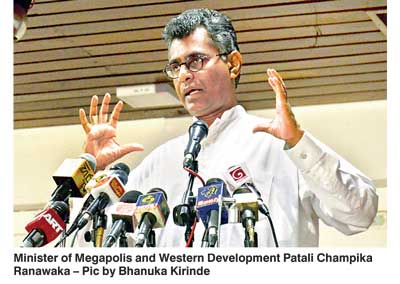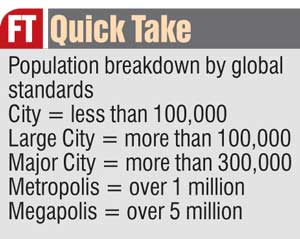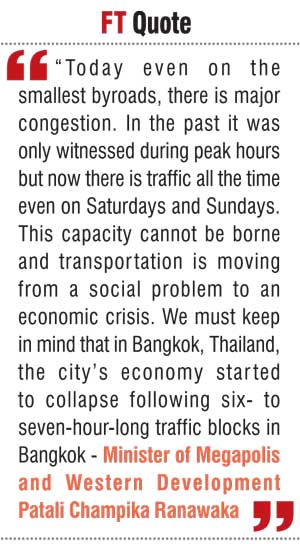Friday Jan 10, 2025
Friday Jan 10, 2025
Monday, 7 December 2015 00:00 - - {{hitsCtrl.values.hits}}
 By Madushka Balasuriya
By Madushka Balasuriya
Minister of Megapolis and Western Development Patali Champika Ranawaka on Monday held the first of several public forums aimed at giving members of the public a chance to interact and offer input with regard to the revamped Western Region Megapolis Planning Project (WRMPP).
First proposed by Prime Minister Ranil Wickremesinghe in 2002, the project was shelved by the arrival of former President Mahinda Rajapaksa in 2005. However, upon the Prime Minister’s political resurgence this year, the project is back in the spotlight.
The project, which is being supervised by the Singaporean Surbana Urban Planning Group, has a stated goal of converting the entire Western Province into one major city - a megapolis - and thereby help Sri Lanka realise its true potential as South Asia’s Economic Hub.
Monday’s forum offered a closer look at some of the preliminary ideas in the pipeline, and the Daily FT has broken down all the key points.
The numbers behind the Megapolis Project
Minister Ranawaka explains: “The Western Province has a population of roughly 6 million and the Government anticipates that the population will be around 8 million by 2030. The land area is 6% of the island, but it has 28% of the population. It had 45% of GDP which has since reduced to 42%. But when you consider the industrial sector, with value addition, 73% of the sector is here.
“In the commercial and financial sectors, 90% of wealth generation happens here. Per capita GDP is 1.6% higher than the rest. There are 1.5 million people in Colombo and Greater Colombo. If you look at the population growth, Gampaha has the largest population. The Colombo city has declined somewhat. The population of Kalutara too is on the rise. A large amount of work happens in Colombo around midday and Colombo is becoming a population centre because of the people who come to the city from various areas, on a daily basis. We can see that around midday, 50% of the people in Colombo have come from other areas, 4% from Maharagama, 4% from Kolonnawa. As such only 50% of the people in Colombo actually live in the city and a similar number are drawn to the city daily.”
Fixing public transportation
Traffic congestion is not a new problem and is widely considered a part of life here. In the month of October alone 60,000 vehicles were brought into the country. 20,000 were cars, the majority of which enter Colombo.
However, Minister Ranawaka assured the public that the Government realises the problem cannot be allowed to fester.
“Today even on the smallest byroads, there is major congestion. In the past it was only witnessed during peak hours but now there is traffic all the time even on Saturdays and Sundays.
“This capacity cannot be borne and transportation is moving from a social problem to an economic crisis. We must keep in mind that in Bangkok, Thailand, the city’s economy started to collapse following six- to seven-hour-long traffic blocks in Bangkok,” he added.
According to the Minister, part of the solution lies in the effective controlling of the ‘seven corridors’.
“The various roads leading to the Colombo City were looked at; one corridor is in Katunayake, or the Negombo Road. Then there is the Kandy road via Kauwela and Kiribathgoda. There is the low level from Hanwella, the Kaduwela Bridge road and the High level road from Homagama. There is the 120 route from Horana via Kesbewa and finally the Galle Road from Moratuwa.
The majority of people use these seven corridors to enter the Colombo City. This data is from 2013, but the latest data indicates that of these corridors, the most number of people enter the city from the Malabe-Kaduwela road, 174 thousand people travel on the road every day. In drawing up a city plan, we understood that it was of the utmost importance to control the flow of traffic on these seven roads.”
Apart from this Ranawaka hopes an increase in urban facilities such as bypass roads, the establishing of multiple centres as opposed to the current single centre model, and improved zoning will help abate the traffic congestion. While he feels money saved from a better run city model will reap dividends.
“We waste 397 billion rupees a year [due to traffic congestion]. So this amount is actually more than enough for a complete overhaul of the transportation sector.”
Addressing low-income housing
According to Minister Ranawaka, one of the worst side effects of the haphazard town planning seen in years gone by is the dire state of low-income housing in Colombo and its suburbs. Of the roughly 670,000-strong population in Colombo, he says 68,000 occupy low-income houses, while there are over 500 beggars. This is in addition to 16,000 stray dogs.
When taking into consideration the whole of the Western Province, the number of those dwelling in low-income housing spikes to over 100,000. This is a problem that the Megapolis Minister realises does not have an easy solution.
“On the one hand, the public are not prepared to leave their dwellings, but you must keep in mind that 95% of the 900 acres of land on which these people are living belongs to the State. There will be social problems when people are resettled in areas. People in our country are bound to the land,” acknowledged Ranawaka.
However, he rejected accusations that the Government was grabbing land belonging to the poor.
“I must make it clear that we are not doing this. We will undertake this task in a way that uplifts the socio-economic status of these people. These people are living off street vendor businesses, three wheelers and sometimes even underworld activity.
“The best stadiums in the country are in Colombo but these 68,000 families have not produced a single national sportsman. Colombo has the best cultural centres in the country but these 68,000 families haven’t produced a single patron, artist or dancer. The best schools in the country are in Colombo but less than 10 of these children make it to university. Thereby when considering these problems, it is evident to us that we need a program to uplift these people even before we start constructing houses for them,” he added.

Waste no more
Waste management has long been a problem in Sri Lanka, let alone the Western Province. While Colombo was rid of it following the previous regime’s beautification drive, mountains of garbage still prevail in Karadiyawa, Kolonnawa and Blumendal among other places.
Ranawaka however was not hesitant on apportioning significant blame on the populace.
“I must note that the people are a large part of this problem. When we attempted to introduce a waste relocation program in Kirindiela and Dompe they said we were clearing the jungle. Today there are waste heaps there. Amid all the protests and hunger strikes, the waste heaps keep growing. So one of the biggest obstacles in Sri Lanka is that protesters prevent the solutions from being implemented. Every time that steps have been taken to solve the issue, false political demonstrations have been held to put a stop to it.”
The minister also revealed that the Government would be putting in place an environmental plan.
“When planning cities we must consider the various situations that could arise as a result of global warming. If sea levels were to rise by ten meters, half of Colombo could be lost as a result of global warming.”
Establishing urban fields
One of the proposals sought out the need to establish various urban fields. This would expand on the idea of the Port City being in the vicinity of the Port, and see a variety of other hubs being established near prominent cities in the Western Province.
“We will use such zoning measures to establish urban fields. We hope to establish cities around the port and airport, in order to use our geographic position for economic progress. Technology will be promoted in Malabe and Homagama to ensure that innovation is encouraged and to enable economic progress in that avenue. We have also selected Aluthgama to attract high-end tourists and in the South, the Dedduwa project from Aluthgama to Mirissa will commence with the assistance of the Urban Development Authority and the Southern Development Authority,” explained Ranawaka.
Smart cities
A smart city uses digital technologies or information and communication technologies to enhance quality and performance of urban services, to reduce costs and resource consumption, and to engage more effectively and actively with its citizens.
Making reference to modern ideas such as the Internet of Things - a proposed development of the internet in which everyday objects have network connectivity, allowing them to send and receive data - Minister Ranawaka outlined a relatively futuristic vision for Sri Lanka.
“The Government is hoping to introduce a new identification card come next year. This ID card will have all your information making it easy for you to do all your day to day work. You will be able to use it as a debit card at a shop, as a passbook at a bank, it will even replace the passport in foreign travel, it can even be used as a bus ticket. So we will introduce this smart ID card next year and parallel to this, we are hoping to improve infrastructure in certain parts of the city to promote this concept of the smart city. Every sector, the economy, transportation, administration, education, the environment, this will be important for us in every sector in the future.”